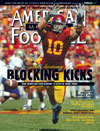AMERICAN FOOTBALL MONTHLY THE #1 RESOURCE FOR FOOTBALL COACHES
Article CategoriesAFM Magazine
|
Gashing the Odd Stack with the Gap Schemeby: Mike Kuchar© More from this issue It has become the most widely used defensive scheme in the country. Following the routes of its forefathers – Rich Rodriguez while at West Virginia and Joe Lee Dunn at Memphis – the odd stack defense has trickled down to most all levels of football and with good reason. Because of the three down linemen structure, coordinators could get their faster athletes on the field to match those spread offenses that have taken shape. But there is a weakness and it’s a glaring one. Ask any odd stack disciple and he will tell you that there is a chink in the armor; it is located in the C gap, between the tackle and tight end in any offensive scheme. Sure, you may not be able to match speed with those outside LBs in that scheme or match wits with the coordinator dialing up blitzes each and every way. But often times you can match br....The full article can only be seen by subscribers. Subscribe today!
|
|
|||||||
| HOME |
MAGAZINE |
SUBSCRIBE | ONLINE COLUMNISTS | COACHING VIDEOS |
Copyright 2025, AmericanFootballMonthly.com
All Rights Reserved





